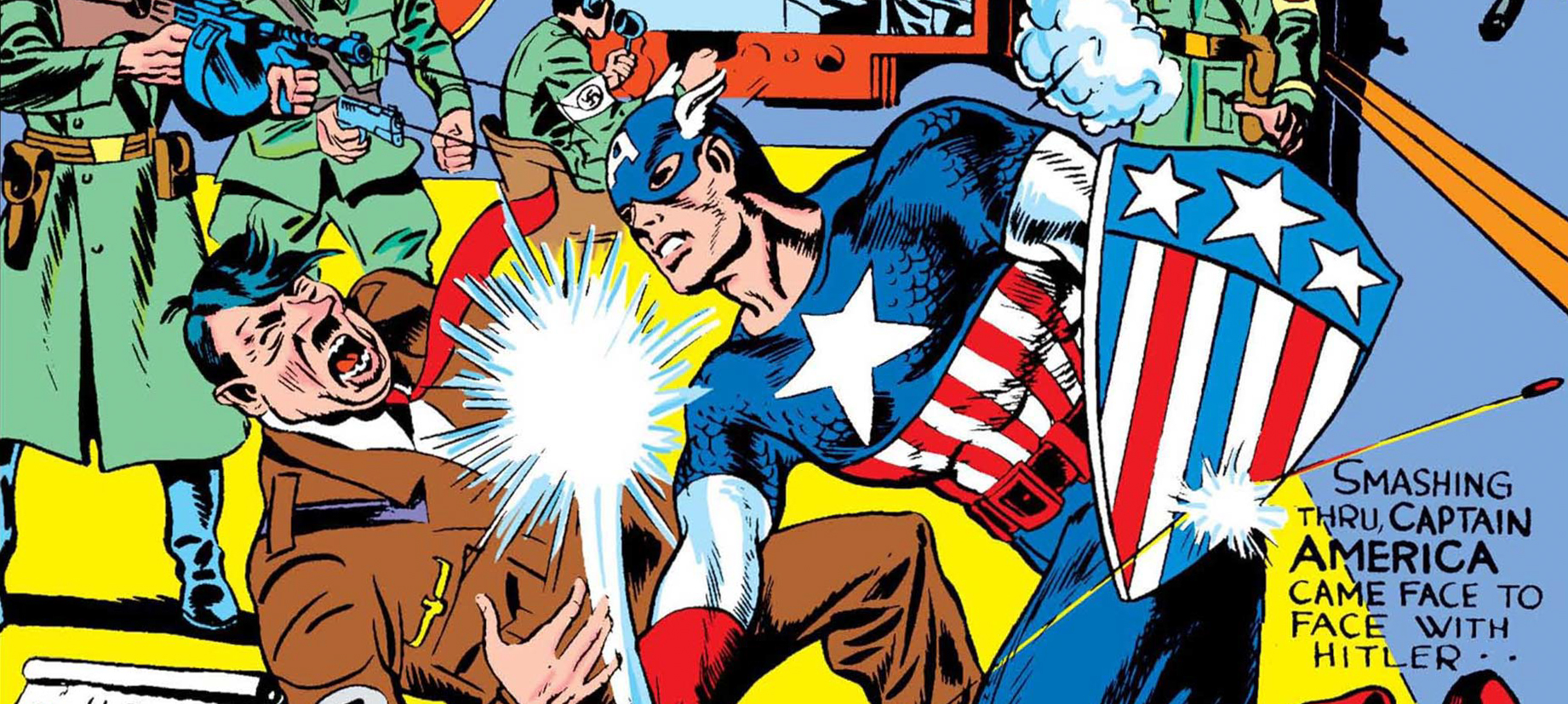Where do I start on this story? I could start at the beginning (“As a child, I loved comic books, particularly the X-Men…”), but I kind of want to start at the moment where I fell in love (again) with Jack Kirby during a GO Train ride.
If you have no idea who I am talking about, Jack Kirby is the one of American comics founding fathers and the co-creator of Captain America, the Fantastic Four, the X-Men and the Hulk.
The Meet Cute
Like most romances, this one begins a meet cute. If you’re not familiar with the term, it describes that moment in a film or television show where there’s an amusing or charming first encounter between two characters that leads to the development of a romantic relationship between them. My meet cute with Jack Kirby occurred on a GO Train heading from Toronto to Mississauga. He was dead, I was alive, and a bunch of total strangers got to watch me laugh, cry, and then finally slouch back into my seat with a satisfied smile on my face.
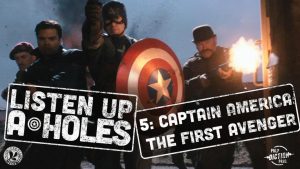 Unreliable narrator moment there. Sorry. I can do better. On the train, I usually listen to music, Podcasts, or read. In that day, I was listening to a Podcast by Chipperish Media called Listen Up A-Holes. Normally, I would be very rigid about my introduction to a new Podcast, insisting I begin with the very first episode, get to know the hosts and their style, and enjoy watching their interactions mature over time into a solid rhythm. Instead of following my tried-and-tested approach to podcast listening, I scanned down the list and selected episode 5, titled Captain America: The First Avenger. (Click here to listen to this episode when you’re done reading the post.) I have not historically been a fan of Captain America, and I wasn’t completely enthralled with the movie when it came out, then I loved it on second viewing, and I couldn’t figure out what had changed. I figured that if this show could help me understand my feelings about the movie a bit better, it would be worth giving the podcast a subscription.
Unreliable narrator moment there. Sorry. I can do better. On the train, I usually listen to music, Podcasts, or read. In that day, I was listening to a Podcast by Chipperish Media called Listen Up A-Holes. Normally, I would be very rigid about my introduction to a new Podcast, insisting I begin with the very first episode, get to know the hosts and their style, and enjoy watching their interactions mature over time into a solid rhythm. Instead of following my tried-and-tested approach to podcast listening, I scanned down the list and selected episode 5, titled Captain America: The First Avenger. (Click here to listen to this episode when you’re done reading the post.) I have not historically been a fan of Captain America, and I wasn’t completely enthralled with the movie when it came out, then I loved it on second viewing, and I couldn’t figure out what had changed. I figured that if this show could help me understand my feelings about the movie a bit better, it would be worth giving the podcast a subscription.
The show hosts are Loni Diane Rich, an expert on story construction, and Joshua Unruh, an expert on comics, working their way through the good, the bad, and the ugly of the Marvel Cinematic Universe (MCU). The podcast format is pretty straightforward. Joshua kicks the show off with four-colour facts relevant (or not) to the story at hand. Four-colour is a reference to the printing process that combines four different ink colors (cyan, magenta, yellow, and black (CMYK)) to create a range of printable colors. Joshua uses his extensive knowledge plus some just-in-time research to go through the comic book history of characters. They then work jointly to try and place the comic story in its original historical context (to help us understand where it came from) and then explain the myriad re-contextualizations that were necessary to drag the old content out of 20s/30s/40s/50s/60s and into a more current timeframe, including all the weird contortions needed to fix into the modern MCU (where most of the stories don’t happen when they actually happened). Then Lani will interject with some basic facts around the production history, ratings, box office performance, and writing teams before they both dive into exploring what worked and what did not work in the storyline. They tie a pretty bow on it with their personal favourite moment before closing out with a quote from the movie.
Speaking of plot, I seem to have lost the thread of mine. I was trying to explain how I fell in love with Jack Kirby on a train. When you get right down to it, it’s all Joshua Unruh’s fault. He told a story about Jack that made me wish I had heard it while he was still alive, and I could get on a train in another direction to go and thank the man the way I really should have.
Mise-en-scène
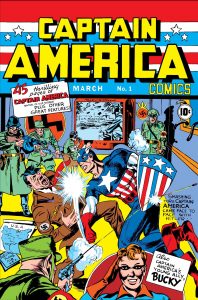 The very first issue of Captain America came out in March 1941. The character was created by Joe Simon and Jack Kirby in Timely Comics, before we even had a Marvel. Jack could write and draw faster than anyone else, but for all his prodigious output, he couldn’t sell his ideas to publishers, which is where Joe came in. Joe was a born salesman who could package Kirby’s art and ensure it got out to the masses. With almost a foot in height between them, Kirby was a scrappy combatant and a whiz with a pencil, and Joe kept them fed.
The very first issue of Captain America came out in March 1941. The character was created by Joe Simon and Jack Kirby in Timely Comics, before we even had a Marvel. Jack could write and draw faster than anyone else, but for all his prodigious output, he couldn’t sell his ideas to publishers, which is where Joe came in. Joe was a born salesman who could package Kirby’s art and ensure it got out to the masses. With almost a foot in height between them, Kirby was a scrappy combatant and a whiz with a pencil, and Joe kept them fed.
The cover of the first comic book in the series features Captain America punching Hitler in the face. Seen from today’s sensibilities, this doesn’t seem that shocking, but you need to remember where the United States was during that spring. Yes, the war was going on, but at this point in time, the US wasn’t involved. American sympathies lay elsewhere. Timely publisher Martin Goodman was Jewish, but he sold comics to kids who for the most part weren’t, across a country where the popular opinion was to keep American troops on this side of both the Atlantic and Pacific. There was a training camp for Nazis in Long Island, just one borough away from the desks where Joe and Jack were sitting. These two Jewish men were writing and drawing comics in a time when comics were wildly popular. Picture it: a million copies of each comic book were selling during the war, and at one point, their circulation exceeded that of Time magazine. Since not everyone could get a hold of their favourite titles each week, it wasn’t an uncommon thing to have people read them over the radio, or re-tell missed stories to their friends.
Anti-semitism was alive and well. America had a strong interest in eugenics and a lot of reasons why they weren’t going to get involved in the war. And yes, let me repeat this: Camp Siegfried was actively training Nazis just down the road from our good friends Joe and Jack.
You start running, they’ll never let you stop.
Jack draws the ideal Aryan man. Tall, strong, blond, blue-eyed… and wrapped in a uniform that was pretty much the American flag. This modern knight was a moral ideal, and he bore a knight’s costume, complete with chainmail, musketeer boots, and a shield. Oddly Captain America bore no sword… his purpose was to defend, he does not attack. Jack drew that Aryan ideal PUNCHING HITLER IN THE NOSE.
Death threats were piling up at the office. Jack and Joe had made a strong statement, and while it is one that is well-supported now, you have to understand that at the time they published that issue, there was a very significant portion of the United States that didn’t want to enter the war, and if they did, were not entirely certain on whose side they would be entering. It was a good ten months before the attack of Pearl Harbour. The death threats got so out of hand that Mayor LaGuardia ordered police protection for Joe and Jack. He was a big fan of their comics, and that would require keeping the creators alive.
On the day in question, Jack is sitting upstairs at his desk, working on some sketches when he gets a call from reception. She explained that there were six Nazis waiting downstairs for Jack to beat him up for the insult of showing Captain America punching Hitler in the nose. Without a pause, he responded with: “Hold on guys, I’ll be right down.” Down he went to meet them, only to find no one there when he arrived. If they wanted to fight, Jack was up for it.
There was a real-life backstory for some of the plot in the movie. A personal backstory. Damn.
Steve Rogers: “I got beat up in that alley. And that parking lot. And behind that diner.”
Peggy Carter: “Did you have something against running away?”
Steve Rogers: “You start running, they’ll never let you stop. You stand up, push back… Can’t say no forever right?”
Sadly, I was sitting on a GO Train when I learned this about Jack Kirby and fell for him, all over again. I’d enjoyed his art and stories for decades. I have lived in a universe he helped create. I have drawn and written stories that take place in that universe. And I fell in love with him again after he died, realizing that I hardly even got to know who he was while he was alive.
It Gets Better, Then It Doesn’t (Lather, Rinse, Repeat)
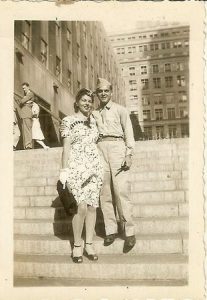
Jack Kirby and his wife Rosalind Goldstein Kirby
Jack Kirby was born Jacob Kurtzberg on August 28, 1917. He grew up in tenement housing on the Lower East Side in New York, the son of poor Austrian immigrants. Since his family didn’t have money to spare, Jacob amused himself growing up by stealing comics from the trash to read first, and then practice drawing on the paper. Boy, could he ever draw! He drew so much and so fast that at one point in his career he was drawing three daily comic strips in three different genres under three different names.
By 1942, Jack entered the war as a combat infantryman. He thought he was heading to the navy, but was instead routed to the army, much to his dismay. His terminal rank was private first class, leaving him with a Combat Infantry Badge, the European-African-Middle Eastern Theater Ribbon with a bronze battle star, and some thoughts about war.
When the post-war comic market hit a decline, Jack rolled with it and shifted from superheroes to romance comics, but there was worse to come. Psychologist Fredric Wertham wrote Seduction of the Innocent, which claimed the depictions of violence, sex, drug use, and other adult fare comics (crime, superhero, horror, or romance) encouraged similar behavior in children. This theory became popular, leading to a rash of comic book burnings and comic publishers being brought before congress to account for themselves. In a desperate attempt to keep the industry alive, they implemented Comics Code Authority which severely restricted what comics could include. These restrictions chafed Jack Kirby in every way, limiting the types of stories he could tell, the images he could draw, and, not to be too blunt: his income.
By 1961, Jack very much needed a change, and when Stan Lee approached him about doing a superhero comic, it offered a turning point. They collaborated on The Fantastic Four, and from there in short order emerged The Incredible Hulk, Thor and Spider-Man (which included art from Steve Ditko). Kirby shifted into high gear, producing more than a hundred pages a month, in an industry where 20 or 30 pages a month was the norm for a hardworking artist. Creatively, an enormous volume of significant work emerged, but the seeds of later troubles were present right from the beginning, as both Jack Kirby and Stan Lee would claim to have first conceived of a number of these characters, foreshadowing future legal battles. They had an odd partnering style, where they’d chat about plot, Kirby would draw the story, and Lee would add in the dialogue after the fact. Eventually, Kirby would charge ahead and produce stories without that first discussion about plot and characters, leaving Lee to figure out what to do with them afterwards. Untangling who created what would remain a topic the two circled back to in later years in an endless string of battles. Jack might have been a creative genius, but he was an awful businessman and never really secured the legal advice and support he needed. As a result, a great many other people grew rich off his ideas, while his family struggled to get by.
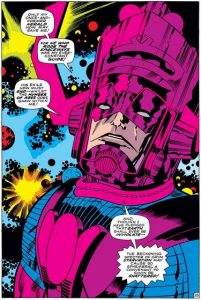 Jack isn’t just the roots of Marvel, his fingerprints can be found in the DC Cinematic Universe as well. His plot bout the the cosmic villain Darkseid invading earth is still happening today in stories. Kirby helped shift comics from vigilante stories to galaxy-spanning space operas, a shift that not only changed comics but hinted at the space from which Star Wars would emerge. Kirby’s stories have a recurrent theme that human destiny lies in groups, not individuals, even if those groups are made up of misfits and freaks. To triumph over evil, we have to come together. Forming such a collectivity is never easy (Kirby’s groups were full of internal strife) but always necessary.
Jack isn’t just the roots of Marvel, his fingerprints can be found in the DC Cinematic Universe as well. His plot bout the the cosmic villain Darkseid invading earth is still happening today in stories. Kirby helped shift comics from vigilante stories to galaxy-spanning space operas, a shift that not only changed comics but hinted at the space from which Star Wars would emerge. Kirby’s stories have a recurrent theme that human destiny lies in groups, not individuals, even if those groups are made up of misfits and freaks. To triumph over evil, we have to come together. Forming such a collectivity is never easy (Kirby’s groups were full of internal strife) but always necessary.
Kirby very much believed in social justice and equality. Why shouldn’t African-Americans have their own superhero? Enter Black Panther. Smart, rich, powerful, and coming from a culture that was more advanced than the western world. Recently, a settlement was made between the Kirby estate and Marvel, which will allow for greater recognition of the man who helped create their empire. Like most superheroes, others have taken a turn at writing Black Panther stories through the decades, but it is important to remember that it all began with the stories and visuals shaped by his co-creator, Jack Kirby.
When Kirby’s name finally appeared in the credits of the Black Panther movie, I cried. I hope that his family feel some joy in the recognition that this man so very rightly deserves.
After all, he punched Hitler.
We miss you, Jack Kirby, and are forever grateful for the legacy you have left us.
Read More
- Looking For The Awesome – 8. Call To Duty by Stan Taylor [article in the Jack Kirby Museum]
- Kirby: King of Comics by Mark Evanier [book]
- Tales to Astonish by Ronin Ro [book]
- Captain America: Still Fighting Nazis, 77 Years Later by Ethan Sacks [article]
- Jack Kirby, the Unknown King by Jeet Herr [article]

